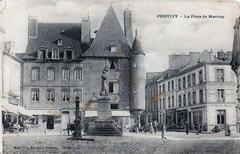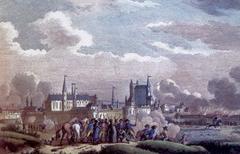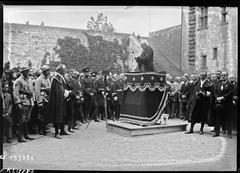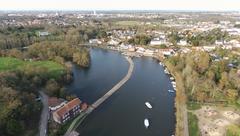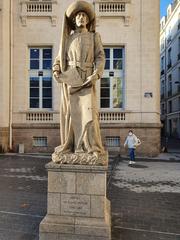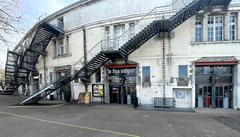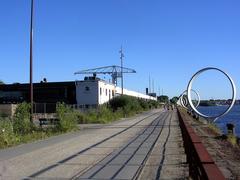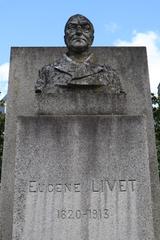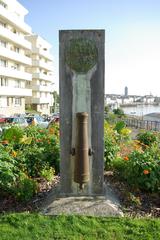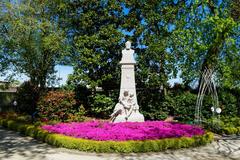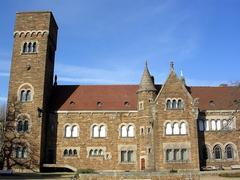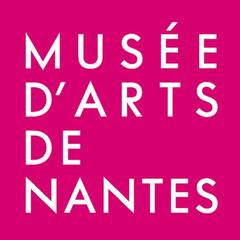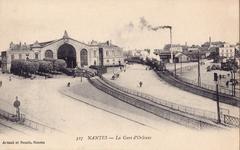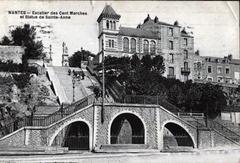Natural History Museum of Nantes: Visiting Hours, Tickets, and Visitor Information
Date: 14/06/2025
Introduction
Nestled in the heart of Nantes, France, the Natural History Museum of Nantes (Muséum d’Histoire Naturelle de Nantes) stands as a testament to centuries of scientific curiosity, education, and cultural preservation. Housed within the historic Hôtel de la Monnaie, this institution traces its roots to the Enlightenment era and the pioneering private collection of François-René Dubuisson. Today, it boasts over 1.5 million specimens, offering visitors a journey through biodiversity, geology, paleontology, ethnography, and more.
The museum’s diverse galleries are designed to captivate all ages. From the awe-inspiring 18-meter fin whale skeleton to immersive vivarium displays (with live reptiles and amphibians), and one of France’s most comprehensive meteorite collections, each exhibit fosters discovery and wonder. Its central location makes it an ideal starting point for exploring other Nantes historical sites, such as the Château des Ducs de Bretagne and the bustling Bouffay district.
As the museum prepares for a major renovation phase beginning in late 2025, now is the perfect time to experience its full range of offerings. For up-to-date details on visiting hours, tickets, and special events, consult the Natural History Museum of Nantes Official Website and the Nantes Tourism Official Site.
Table of Contents
- Introduction
- History and Development
- Collections and Scientific Importance
- Visiting Hours and Tickets
- Accessibility and Visitor Services
- Events, Guided Tours, and Workshops
- Educational Role and Community Engagement
- Architectural Significance
- Nearby Nantes Historical Sites
- Travel Tips
- Renovation Notice
- FAQs
- Visual and Media Recommendations
- Conclusion and Key Takeaways
- References
History and Development
Origins and Early Development
The museum’s origins date back to the late 18th century, when François-René Dubuisson, a local pharmacist and naturalist, began amassing a collection dedicated to cataloguing the natural world (Official Museum Website). Acquired by the city in the early 19th century, this collection became the foundation for the museum, officially established as a public institution focused on conservation, study, and education.
Expansion and Institutional Growth
Throughout the 19th and 20th centuries, the museum grew through acquisitions and donations from explorers, scientists, and collectors. The 1950s saw the addition of a vivarium, introducing live animal exhibits and interactive learning. In the 1990s, the expansion into the historic Hôtel de la Monnaie enabled the museum to reorganize its displays, blending historic architecture with modern exhibition techniques (Nantes Tourism Official Site).
Collections and Scientific Importance
Zoology
The museum’s zoology gallery is a highlight, featuring over 1,000 vertebrate specimens, including the dramatic 18-meter fin whale skeleton suspended from the ceiling. The gallery also houses a rich array of birds, mammals, reptiles, and marine life, illustrating biodiversity from both local and global perspectives (The Crazy Tourist, Le Voyage à Nantes).
Botany and Malacology
With approximately 300,000 herbarium specimens, the botany collection documents plant diversity from the Loire region and beyond. The malacology displays feature thousands of shells and mollusks, highlighting their ecological significance.
Mineralogy and Paleontology
Geology enthusiasts will appreciate the museum’s meteorite collection—one of the most extensive in France—as well as mineral specimens and fossils that reveal Earth’s geological history (Museum Nantes).
Vivarium
Established in 1955 and renovated in 2003, the vivarium offers close-up views of live regional and exotic reptiles and amphibians, fostering conservation awareness and public engagement (WhichMuseum).
Ethnography and Marquis d’Abadie’s Study
The museum preserves significant ethnographic collections and a reconstructed early 20th-century study honoring Marquis d’Abadie, providing a glimpse into the lives of naturalists and explorers from Nantes’ past (Wikipedia).
Special Exhibitions
Temporary exhibitions such as “Trésors & Biodiversité” (until November 3, 2025) showcase rare and never-before-seen specimens, emphasizing the museum’s commitment to biodiversity and scientific research (Le Voyage à Nantes).
Visiting Hours and Ticket Information
- Hours: Tuesday–Sunday, 10:00 AM–6:00 PM (extended hours during summer). Closed Mondays and major holidays.
- Tickets: Adults €6; reduced rate €4 (students, seniors); free for children under 18, Nantes Pass holders, and on the first Sunday of each month (September–June). Tickets can be purchased on-site or online (Official Museum Website).
- Location: 12 rue Voltaire, 44000 Nantes, France.
- Transport: Easily accessible by tram (Lines 1 and 2, stop “Commerce”), bus, and public parking nearby.
Accessibility and Visitor Services
The museum is fully accessible, offering ramps, elevators, and adapted restrooms. Wheelchairs are available on request, and staff are trained to assist visitors with disabilities (Le Voyage à Nantes). Multilingual signage and guides, as well as tactile exhibits, ensure an inclusive experience.
Amenities include a cloakroom, gift shop, free Wi-Fi, rest areas, and an information desk with multilingual staff. While there’s no on-site café, plenty of dining options can be found nearby.
Events, Guided Tours, and Workshops
Regularly scheduled guided tours (in multiple languages), workshops, and family activities enrich the museum experience. Advance booking is recommended for groups and special events. Hands-on activities and scavenger hunts are especially popular with children (event calendar).
Educational Role and Community Engagement
Education is central to the museum’s mission. Collaborations with schools, universities, and cultural organizations support scientific literacy and public engagement. The vivarium, interactive workshops, and temporary exhibitions foster curiosity and environmental stewardship among visitors of all ages.
Architectural Significance
Housed in the 19th-century Hôtel de la Monnaie, the museum seamlessly integrates historic charm and modern accessibility. The building itself is a piece of the city’s heritage, offering an elegant backdrop to scientific exploration.
Nearby Nantes Historical Sites
The museum’s central location makes it easy to visit other Nantes attractions:
- Château des Ducs de Bretagne: Medieval castle and museum.
- Jardin des Plantes: Renowned botanical gardens.
- Les Machines de l’Île: Mechanical art installations.
- Bouffay District: Historic quarter filled with shops and restaurants (Lonely Planet).
Travel Tips
- Best times to visit: Weekdays, especially mornings or late afternoons, are less crowded.
- Advance booking: Recommended during weekends, holidays, and for guided tours or special events.
- Public transport: Favor public transit over driving to avoid parking challenges.
- Photography: Allowed in most areas without flash; check exhibit-specific policies.
Renovation Notice
The museum will close for major renovations from November 2025 to approximately 2029. The vivarium, scientific library, and media library will close from January 1, 2025. Plan visits accordingly to enjoy all exhibits before these closures (Le Voyage à Nantes).
FAQs
Q: What are the museum’s opening hours?
A: Tuesday–Sunday, 10:00 AM–6:00 PM; closed Mondays and major holidays.
Q: How much are tickets?
A: Adults €6; reduced €4; free for children under 18 and on the first Sunday of the month (September–June).
Q: Is the museum accessible?
A: Yes, the museum is fully accessible to visitors with disabilities.
Q: Are guided tours available?
A: Yes, guided tours are offered in several languages and can be booked in advance.
Q: Can I see live animals?
A: Yes, in the vivarium (open until January 2025).
Q: Is photography allowed?
A: Non-flash photography is permitted in most galleries.
Visual and Media Recommendations
To enhance your visit or article, use high-quality images of the fin whale skeleton, vivarium, and the museum’s historic exterior. Include descriptive alt text like “Fin whale skeleton at Natural History Museum of Nantes.” Consider embedding a virtual tour or map for added interactivity.
Conclusion and Key Takeaways
The Natural History Museum of Nantes offers a unique blend of scientific exploration, cultural heritage, and interactive learning. Its comprehensive collections, family-friendly programming, and commitment to accessibility make it an essential stop for visitors of all ages. As renovations approach, seize the opportunity to experience the museum’s treasures and the vibrant history of Nantes. For the latest information, always refer to the official museum website and the Nantes tourism portal.
References
- Natural History Museum of Nantes: Visiting Hours, Tickets, and Exploring Nantes Historical Sites, 2025, Official Museum Website (https://musee-histoire-naturelle.nantes.fr)
- Visiting the Natural History Museum of Nantes: Hours, Tickets, Highlights, and Visitor Guide, 2025, Nantes Tourism Official Site (https://www.nantes-tourisme.com/en)
- Must-See Exhibits and Galleries at the Natural History Museum of Nantes: Visiting Hours, Tickets, and Nantes Historical Sites Guide, 2025, Le Voyage à Nantes (https://www.levoyageanantes.fr/en/places/natural-history-museum/)
- Natural History Museum Nantes Visiting Hours, Tickets, and Visitor Guide, 2025, Museum Nantes Official Site (https://museum.nantesmetropole.fr/)
- The Crazy Tourist
- WhichMuseum
- Museum Nantes
- Wikipedia
- Loire Lovers
- Lonely Planet
